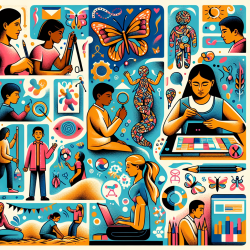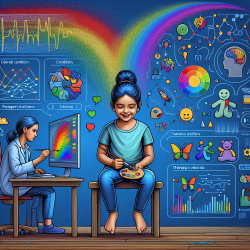Introduction
The COVID-19 pandemic has dramatically altered the landscape for adolescents, particularly those in vulnerable situations such as refugee and host communities in Jordan. A recent study titled "Compounding inequalities: Adolescent psychosocial wellbeing and resilience among refugee and host communities in Jordan during the COVID-19 pandemic" sheds light on the compounded challenges faced by these groups. This blog will explore how practitioners can leverage the findings from this study to enhance therapeutic outcomes for children, particularly those in similar vulnerable contexts.
Understanding the Study's Findings
The study utilized a mixed-methods approach, combining quantitative survey data and qualitative interviews with over 3,000 adolescents, including Syrian refugees, stateless Palestinians, and vulnerable Jordanians. The findings revealed significant disruptions in economic and service sectors, leading to increased stress and mental health challenges among adolescents.
- 19.3% of adolescents exhibited symptoms of moderate-to-severe depression.
- Social connectedness was notably low for girls, who were 13.4 percentage points more likely than boys to have had no interaction with friends in the past week.
- Participation in adolescent programming showed protective effects, especially for girls, who were 8.8 percentage points more likely to have a trusted friend.
Implications for Practitioners
Practitioners can draw several actionable insights from this study to improve therapeutic outcomes:
1. Focus on Building Resilience
Given the study's findings on resilience, practitioners should incorporate resilience-building strategies into their therapeutic practices. This can include teaching adaptive coping mechanisms, fostering supportive peer networks, and encouraging participation in structured programs that promote social interaction and skill development.
2. Address Gender-Specific Challenges
The study highlights the unique challenges faced by girls, particularly in maintaining social connections. Practitioners should tailor interventions to address these gender-specific barriers, ensuring that girls have access to safe spaces for interaction and support.
3. Leverage Technology
With the shift to virtual learning and therapy, technology can be a powerful tool in maintaining continuity of care. Practitioners should explore digital platforms that facilitate engagement and interaction, ensuring that children remain connected to their support networks.
Encouraging Further Research
While this study provides valuable insights, there is a need for ongoing research to understand the long-term impacts of the pandemic on adolescent wellbeing. Practitioners are encouraged to contribute to this body of knowledge by documenting and sharing their experiences and outcomes.
To read the original research paper, please follow this link: Compounding inequalities: Adolescent psychosocial wellbeing and resilience among refugee and host communities in Jordan during the COVID-19 pandemic.










